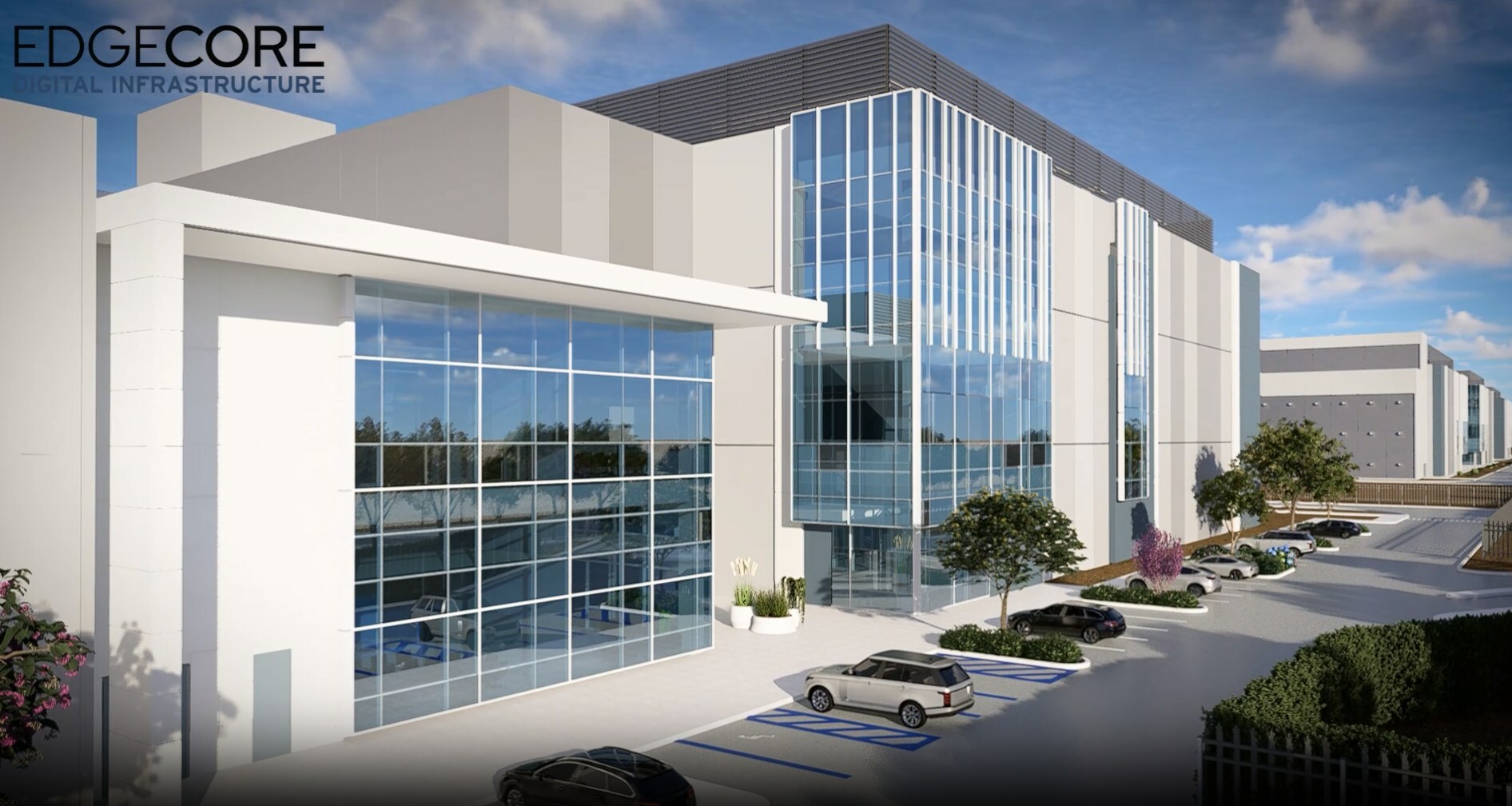Will the Data Center Industry Grow More in ’24?
In this 2024 outlook report, experts weigh in on the prospects for this increasingly popular asset class.

Ryan Mallory believes that in 2024, forward-thinking leaders will diversify their footprints into new, regional markets, aiming to circumvent supply chain constraints of primary metros. Image courtesy of Flexential
Data centers have racked up another spectacular year. Despite a slowing economy and a business environment marked by uncertainty, the industry has seen strong fundamentals, with growth in primary markets continuing at a record pace. Demand is only increasing, fueled by the rapid proliferation of AI technology.
Several landmark moves made waves in 2023, and some of them will likely have a huge impact on the sector going forward. For example, Blackstone‘s recent $7 billion joint venture with Digital Realty is set to deploy 500 megawatts across three primary markets over the next few years, while Amazon Web Services‘ plans to invest $7.8 billion in Central Ohio is set to bring more data centers to the area over the next six years.
READ ALSO: How the Cost of Building Is Shaping Up for 2024
But despite developers keeping a strong pace of new projects throughout both primary and secondary markets, economic hurdles and other types of challenges remain on several key levels.
Large deployments are no longer overwhelmingly the realm of primary markets, as some of those have become saturated and constrained by either a lack of developable land or limited power capacity. This, in turn, has generated premium prices.
According to Cushman & Wakefield Head of Alternative Insights Jacob Albers, vacancy rates in all primary markets in North America are below 5 percent, with a few even falling below 1 percent—such as Northern Virginia. These record low figures will continue to push lease pricing, pressuring operators to examine secondary markets and outlying areas of established ones.
Power availability will drive growth

Jacob Albers thinks that data centers will continue to remain a niche sector with a high barrier to entry, due to the complexities of developing these facilities. Image courtesy of Cushman & Wakefield
Colton Brown, vice president of strategy and development at Aligned Data Centers, believes that market tier designations are becoming increasingly irrelevant, as there are individual campuses now that can deliver as much capacity as multiple Tier 2 markets combined. What will drive growth in these markets is power availability. As some primary data center areas, including Silicon Valley and Loudoun County, Va., continue to have issues with power, developers and operators will move on to new markets where these concerns don’t yet exist.
“Notably, it is a growing belief that most AI learning facilities will not have stringent latency requirements, enabling data center operators to evaluate sites hundreds of miles away from traditional cloud regions,” Albers told Commercial Property Executive.
Tertiary markets and rural areas will likely see an increase in announcements for hyperscale builds. Record-setting power purchase agreements have been signed in midwestern and southern markets, which will probably continue through next year in other areas as well.
“Forward-thinking leaders will diversify their data center footprint into new, regional markets, aiming to further circumvent supply chain constraints and overcome the rising operational costs in Tier 1 cities,” Flexential COO Ryan Mallory expects.
Markets to watch in 2024 include Columbus, Ohio; Kansas City, Mo.; Omaha, Neb., Des Moines, Iowa; Reno, Nev., along with metros in Arizona, Tennessee, The Carolinas and Georgia. What these regions have in common are growing and upcoming renewable energy plants. Power will be a crucial factor in 2024 and beyond.

EdgeCore’s upcoming 1.5 million-square-foot, 216-megawatt campus in Reno, Nev., is a project for which the developer secured power agreements with utility provider NV Energy. EdgeCore is targeting LEED certification for the campus. Rendering courtesy of EdgeCore Digital Infrastructure
Providers and developers will look to secure commitments for power as early as possible in the process.
“This is quite a change from a few years ago when land would be secured and pre-development steps engaged before a power commitment was negotiated,” Albers noticed.
A roadmap and commitment to sufficient power is a pre-condition of securing land now. EdgeCore Chief Commercial Officer Clint Heiden agrees that securing power will be among the top issues that the data center sector will face.
“Moving forward, we are likely to see land acquisition practices begin by identifying areas with available power and then searching for developable land nearby,” Heiden told CPE.
The EdgeCore executive believes that how fast a project is brought to market will no longer be a bottleneck. Rather, the speed at which developers can secure power and equipment for the site and how they can manage supply chain delays will be more of a constraint going forward. Heiden anticipates these issues to continue to play out as a primary hurdle in 2024 and beyond, as data centers are constructed, retrofitted and expanded to meet modern density demands.
Leveraging AI will require updated infrastructure
Over the past decade, large land sites for data center campuses have become a common occurrence—sites ranging from 100 acres to more than 500 acres tied into developers’ strategy of mitigating land price fluctuations, as well as meeting hyperscale demand.

“The move toward creating more efficient, scalable data centers that can handle the enormous demand of AI and ML will continue to be a core theme in the foreseeable future,” Heiden told CPE. Image courtesy of EdgeCore Digital Infrastructure
Today, AI is triggering a paradigm shift in terms of infrastructure. While power availability will be vital, this new technology will have a huge impact on other aspects, as well.
“Everything else is or will be different—cooling systems, redundancy levels, latency and network requirements and more,” Brown said.
Vantage Data Centers Senior Vice President of Sales and Solutions Engineering Steve Conner told CPE that AI deployments can reach rack densities up to five times higher than traditional cloud computing, which leads to cooling requirements also becoming more complex. Increasing demand for high-density AI deployments has already prompted discussions around reconfiguring data center layouts to account for liquid cooling distribution units closer to the racks while delivering the space necessary to support the plumbing systems.
“The cooling technology itself likely won’t change too much, rather it comes down to a conversation about liquid versus air and the associated ratios,” Conner noted.
At first, there probably won’t be drastic changes with the technology itself. However, data center operators will likely make changes at the design and architecture specification level, to make sure their buildings can support this additional infrastructure.
Generally, AI, machine learning and high-performance computing will drive higher rack density requirements, which will range between 25 to 100 kW per rack—in the past, it was common to have densities of under 15 kW per rack. Working toward technologies that can balance the needed cooling with reducing environmental impact through recycling water usage and waste heat will also be a key issue going forward, Albers believes.
Sustainability-linked instruments will proliferate

Colton Brown pointed out that the push for efficiency is not unique to AI—from water efficiency to power, land and capital efficiency, all resources are finite and must be utilized in a sustainable way. Image courtesy of Aligned Data Centers
As the need for higher scale rises, so too will the focus on sustainable development and operation. Organizations will increase their focus on ESG managing and reporting, which will initially lead to higher Scope 2 and 3 emissions as these processes evolve, according to Mallory.
Flexential’s latest generations of data centers are all built with climate-optimized features, including power usage effectiveness of 1.25 and water usage effectiveness at zero, while their cooling infrastructure mitigate the company’s carbon footprint.
Overall, developers’ focus to positively change how the data center industry impacts the environment has generated multiple-faceted initiatives at all levels. As new facilities are being designed, owners are considering the environmental needs of the geography they are based in. In water-constrained markets, for example, utilizing closed-loop systems is a way to mitigate the use of this precious resource.
“Providers should continue to nurture the ecosystem between local communities, governments and power companies as the industry works to be more efficient and sustainable,” Heiden said.
READ ALSO: 2024 Forecast—More of the Same?
Those who want to bring modern data centers to the market need to strike a balance between debt financing and equity capital in order to be successful.
“Providers must be more intentional when determining the optimal capital structure, especially when meeting capacity demands driven by AI and hyperscalers, among other factors,” Heiden mentioned.
A solution to reaching this balance is green financing, which will continue to gain traction in 2024, specialists agree. Companies have begun using green bonds and sustainability-linked loans, along other similar financial instruments. Vantage, AirTrunk, Aligned, EdgeConnex and many others all utilized these methods a lot more in 2023.
Next year and beyond, the data center industry will likely continue its strong growth across all fundamentals, but a key aspect for all players going forward will be the collaboration with local utility providers and community groups to advance the sector’s sustainability goals.







You must be logged in to post a comment.